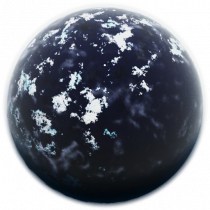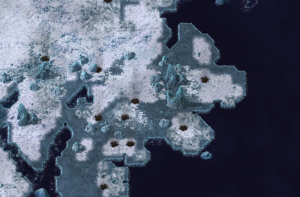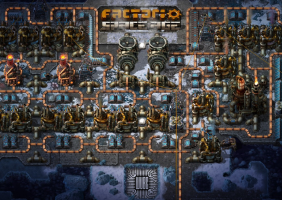Aquilo: Difference between revisions
ACryInShame (talk | contribs) No edit summary |
ACryInShame (talk | contribs) (Orbit and Surface information added with travel distances and some organization) |
||
| Line 13: | Line 13: | ||
*{{NavboxIconLink|Fusion reactor}}{{SA}} | *{{NavboxIconLink|Fusion reactor}}{{SA}} | ||
*{{NavboxIconLink|Railgun turret}}{{SA}} | *{{NavboxIconLink|Railgun turret}}{{SA}} | ||
==Space routes== | |||
{{NavboxIconLink|Gleba}} is connected to 2 other planets, {{NavboxIconLink|Fulgora}}{{SA}} and {{NavboxIconLink|Gleba}}{{SA}}, along with the {{NavboxIconLink|solar system edge}}{{SA}} | |||
{| class="wikitable" | |||
|+ Planet Distance | |||
|- | |||
! Planet !! Distance (KM) | |||
|- | |||
| {{NavboxIconLink|Fulgora}}{{SA}}|| 30,000 | |||
|- | |||
| {{NavboxIconLink|Gleba}}{{SA}}|| 30,000 | |||
|- | |||
| {{NavboxIconLink|solar system edge}}{{SA}}|| 100,000 | |||
|} | |||
Asteroid rate graphs: | |||
<br> | |||
-- This is a space holder for when the Gleba graphs are added -- | |||
{| class="wikitable" style="text-align:center;" | |||
|- | |||
| [[File:Asteroid_chart_Gleba_Aquilo.png]] <br> Space route from {{NavboxIconLink|Gleba }} to {{NavboxIconLink|Aquilo}} | |||
| [[File:Asteroid_chart_Fulgora_Aquilo.png]] <br> Space route from {{NavboxIconLink|Fulgora}} to {{NavboxIconLink|Aquilo}} | |||
| [[File:Asteroid_chart_Aquilo_Solar_System_Edge}.png]] <br> Space route from {{NavboxIconLink|Aquilo}} to {{NavboxIconLink|solar system edge}} | |||
|} | |||
Graph legend: | |||
<table class="wikitable"> | |||
<tr> | |||
<th>Asteroid type</th> | |||
<th>Chunk</th> | |||
<th>Medium</th> | |||
</tr> | |||
<tr> | |||
<td>[[File:Metallic asteroid chunk.png|32px]] Metallic</td> | |||
<td><span style="color: blue;">●</span> Blue</td> | |||
<td><span style="color: red;">●</span> Red</td> | |||
</tr> | |||
<tr> | |||
<td>[[File:Carbonic asteroid chunk.png|32px]] Carbonic</td> | |||
<td><span style="color: orange;">●</span> Orange</td> | |||
<td><span style="color: yellow;">●</span> Yellow</td> | |||
</tr> | |||
<tr> | |||
<td>[[File:Oxide asteroid chunk.png|32px]] Oxide</td> | |||
<td><span style="color: green;">●</span> Green</td> | |||
<td><span style="color: magenta;">●</span> Magenta</td> | |||
</tr> | |||
</table> | |||
==Orbit== | |||
===Properties=== | |||
{| class="wikitable" | |||
|- | |||
! Property !! Value | |||
|- | |||
| Solar Power || 60% | |||
|- | |||
|} | |||
{| class="wikitable" | |||
|+ Asteroid Spawning Types | |||
|- | |||
! [[Asteroids| Asteroid]] Type !! Spawn Ratio | |||
|- | |||
| {{NavboxIconLink|Metallic asteroid chunk}} {{SA}}|| 1 | |||
|- | |||
| {{NavboxIconLink|Carbonic asteroid chunk}} {{SA}}|| 2 | |||
|- | |||
| {{NavboxIconLink|Oxide asteroid chunk}} {{SA}}|| 20 | |||
|- | |||
| {{NavboxIconLink|Promethium asteroid chunk}} {{SA}}|| 0 | |||
|} | |||
{| class="wikitable" | |||
|+ Asteroid Spawning Sizes | |||
|- | |||
! [[Asteroids| Asteroid]] Size !! Spawn % | |||
|- | |||
| Chunk|| .10 | |||
|- | |||
| Medium|| 0 | |||
|- | |||
| Big || 0.25 | |||
|- | |||
| Huge || 0 | |||
|} | |||
'''Note:''' | |||
*Chunks spawn at Nauvis at 1.25% | |||
*Huge Asteroids only spawn past [[Aquilo]]{{SA}} | |||
==Surface== | |||
===Properties=== | |||
{| class="wikitable" | |||
|+ Gleba Surface Properties | |||
|- | |||
! Property !! Value | |||
|- | |||
| Pollutant Type || None | |||
|- | |||
| Day Night Cycle || 20 Minutes | |||
|- | |||
| Magnetic Field|| 10 | |||
|- | |||
| Solar Power || 01% | |||
|- | |||
| Pressure || 300 | |||
|- | |||
| Gravity || 15 | |||
|} | |||
=== Natural Resources === | === Natural Resources === | ||
Revision as of 20:10, 8 November 2024
| This article is a stub, and not comprehensive. |
|---|
| You can help this wiki by expanding it. |
![]() Space Age expansion exclusive feature.
Space Age expansion exclusive feature.
Aquilo a desolate, freezing ocean planet. Its surface consists solely of a vast ocean of liquid ammonia, with the occasional floating iceberg.
Required Research
Exclusive items
The following items are unlocked on Aquilo:
Space routes
Gleba is connected to 2 other planets, Fulgora![]() and Gleba
and Gleba![]() , along with the solar system edge
, along with the solar system edge![]()
| Planet | Distance (KM) |
|---|---|
| Fulgora |
30,000 |
| Gleba |
30,000 |
| solar system edge |
100,000 |
Asteroid rate graphs:
-- This is a space holder for when the Gleba graphs are added --
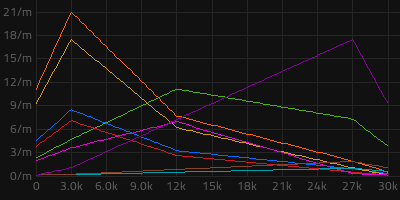 Space route from Gleba to Aquilo |
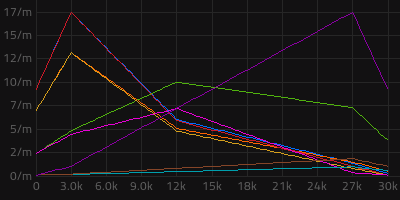 Space route from Fulgora to Aquilo |
[[File:Asteroid_chart_Aquilo_Solar_System_Edge}.png]] Space route from Aquilo to solar system edge |
Graph legend:
| Asteroid type | Chunk | Medium |
|---|---|---|
| ● Blue | ● Red | |
| ● Orange | ● Yellow | |
| ● Green | ● Magenta |
Orbit
Properties
| Property | Value |
|---|---|
| Solar Power | 60% |
| Asteroid Type | Spawn Ratio |
|---|---|
| Metallic asteroid chunk |
1 |
| Carbonic asteroid chunk |
2 |
| Oxide asteroid chunk |
20 |
| Promethium asteroid chunk |
0 |
| Asteroid Size | Spawn % |
|---|---|
| Chunk | .10 |
| Medium | 0 |
| Big | 0.25 |
| Huge | 0 |
Note:
- Chunks spawn at Nauvis at 1.25%
- Huge Asteroids only spawn past Aquilo

Surface
Properties
| Property | Value |
|---|---|
| Pollutant Type | None |
| Day Night Cycle | 20 Minutes |
| Magnetic Field | 10 |
| Solar Power | 01% |
| Pressure | 300 |
| Gravity | 15 |
Natural Resources
In terms of directly exploitable natural resources, Aquilo has:
With crude oil being the only non-exclusive resource to Aquilo.
Stone, iron and copper need to be imported from other planets as Aquilo lacks ways to obtain these from the environment.
Mechanics
Freezing
Aquilo is brutally cold. All entities will freeze and stop working unless heated by a heat pipe in an adjacent tile. Heat can be generated by the nuclear reactor or heating tower. Buildings also cannot be placed on the surface of the iceberg itself; concrete (or its variants) must be placed underneath as an insulator. The harshly low temperature will also make construction robots and logistic robots much weaker, making them consume 5 times more power than normal.
Aquilo is also far from the sun, and so solar panels only output at 1% of their rate on Nauvis, or 0.6 kW during the day.
Gallery
See also
Trivia
- In mythology, Aquilo is the Roman god of the north wind, storms, and winter.
